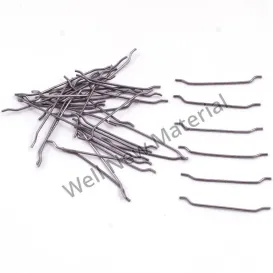FAQs | Everything You Need to Know About Steel Fiber in Concrete
Steel fiber is an essential component in the modern construction industry, known for its ability to significantly enhance the performance and longevity of concrete. These small steel strands are incorporated into concrete mixes to improve its mechanical properties, providing greater strength and resilience. This article explores the various benefits, applications, and important factors to consider when using steel fiber in concrete, offering valuable insights for both professionals and enthusiasts in the field.
Understanding Steel Fiber
Steel fiber consists of short, thin strands of steel that are blended into concrete, enhancing its overall properties. Fibers may come in various shapes, including straight, hooked, crimped, or twisted, each shape affecting the concrete’s performance in unique ways. Usually fabricated from either carbon or stainless steel, these fibers are incorporated into the concrete mixture according to the desired performance specifications.

Enhancements Provided by Steel Fiber
Incorporating steel fibers into concrete yields several key benefits:
Increased Tensile Strength: The addition of steel fibers enhances the tensile strength of concrete, which is inherently weak in tension, making the material more resistant to cracking and breaking under stress.
Improved Flexural Strength: Steel fibers help distribute stress evenly across the concrete, enhancing its ability to bend without fracturing.
Enhanced Durability: By inhibiting micro-crack formation and controlling the extension of larger cracks, steel fibers significantly improve the longevity and robustness of concrete structures.
Elevated Impact Resistance: Concrete that is reinforced with steel fibers can effectively absorb and dissipate energy, thus improving its ability to resist impacts and dynamic loads.
Reduced Shrinkage and Creep: The presence of steel fibers helps in minimizing shrinkage and creep, preserving the shape and structural integrity of the concrete over time.
Practical Uses of Steel Fiber in Concrete
Steel fiber finds its application in a multitude of sectors within the construction industry, including:
Industrial Flooring: Steel fiber-reinforced concrete offers exceptional strength and durability, making it suitable for industrial floors that need to withstand heavy loads and frequent use.
Pavement and Overlays: Due to its improved properties, steel fiber-reinforced concrete is excellent for pavements and overlays, resulting in a longer lifespan and lower maintenance costs.
Shotcrete Applications: In tunneling and mining, steel fiber-reinforced shotcrete provides better support and stability, mitigating the risk of collapse.
Precast Concrete Products: The incorporation of steel fibers enhances the strength and durability of precast concrete items such as pipes, tanks, and panels.
Construction of Bridges and Tunnels: The remarkable strength and durability enable steel fiber-reinforced concrete to be ideally suited for use in bridges and tunnels where structural integrity is essential.
Determining Fiber Proportions
The appropriate proportion of steel fiber to add to concrete is influenced by multiple factors including the required mechanical properties, specific application, and the mix design. Typically, fiber content ranges from 0.25% to 2.5% by volume of concrete. It is vital to perform comprehensive testing and consult relevant standards to define the optimal content for each application.
Mixing and Application Techniques
Correct mixing and application practices are essential to achieve the desired characteristics of steel fiber-reinforced concrete:
Mixing: Ensuring uniform distribution of fibers throughout the concrete mix is crucial for consistent performance, which can be accomplished using standard mixing equipment with modifications for fiber addition.
Placement: During placement, careful measures should be taken to avoid fiber segregation and ensure even distribution. Standard concrete placement techniques remain effective, with additional compaction methods if required.
Finishing Touches: Traditional finishing methods can be employed on steel fiber-reinforced concrete, but additional caution is needed to prevent fibers from being pulled to the surface, maintaining a smooth finish.
Advantages of Steel Fiber in Concrete
Utilizing steel fiber in concrete offers multiple advantages:
Improved Structural Performance: Steel fibers significantly enhance the structural capability of concrete, resulting in a stronger and more resilient material.
Economical Solution: Although the initial expense of steel fibers may be higher than traditional reinforcements, the long-term cost savings through reduced maintenance and extended lifespan make them economically favorable.
Versatility: Steel fiber-reinforced concrete is adaptable for various applications, ranging from industrial flooring to precast products, providing extensive design and construction flexibility.
Promoting Sustainability: The use of steel fibers can lead to more sustainable building practices by minimizing the need for supplementary reinforcement and prolonging the functional life of concrete structures.
Challenges and Key Considerations
While steel fiber presents numerous advantages, certain challenges must be addressed:
Initial Investment: The starting cost of steel fibers can be greater than conventional reinforcement methods, a factor to consider for budget-constrained projects.
Workability Issues: Adding fibers may alter the workability of concrete, resulting in a stiffer mix that could complicate placement and finishing. Proper mix design and placement methods are essential to manage this issue.
Corrosion Concerns: While stainless steel fibers resist corrosion effectively, carbon steel fibers may be vulnerable in harsh environments, necessitating protective measures to ensure durability over time.
Conclusion
Incorporating steel fiber into concrete provides significant improvements in strength, durability, and overall performance. By understanding its properties, diverse applications, and significant considerations, construction professionals can optimize concrete mixes for various projects. When managed correctly, steel fiber-reinforced concrete emerges as a cost-effective, versatile, and sustainable option for the contemporary construction landscape.
- Previous: None
- Next: None


